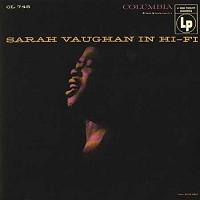Give The Sassy One Space and She'll Fill It!
Bop clarinetist Tony Scott (born Anthony Joseph Sciacca in Morristown, NJ), who plays on this Sarah Vaughan album as part of an octet that includes Miles Davis (then 24), passed away the day before this was written, on the last day of March, 2007. An obit I read says that the eclectic Mr. Scott also arranged “The Banana Boat Song (Day-O)” for Harry Belafonte. As I write this sentence, his velvety clarinet sings prettily behind Vaughan at the end of “It Might As Well Be Spring.”
This album, recorded December, 1949 and May, 1950, would not be considered “high fidelity” by contemporary standards, or even those of the mid-fifties. In fact it wasn’t and isn’t an “album” at all, as the new liner notes by Phil Schapp and Dick Katz will tell you.
Instead, Sarah Vaughan In Hi-Fi is an exploitation album, much like the Jimi Hendrix album Get That Feeling issued by Capitol after the success of Hendrix’s Reprise debut Are You Experienced?. Vaughan had moved over to Mercury and released Sarah Vaughan in the Land of Hi-Fi, so Columbia issued this collection in response.
However, while the Hendrix Capitol was a truly bogus move since the music was pre-Experience r&b and not what fans were expecting and featured a misleading picture of psychedelic Jimi, not soul Jimi, this album was anything but bogus.
Via the liner notes you will discover the history that produced the original single 12 inch LP edition of this record, which was cobbled together from Vaughan’s only real Columbia LP, a 10 incher called Sarah Vaughan, to which were added some other tracks to fill the 12 inch side that produced Sarah Vaughan In Hi-Fi. This double LP adds alternative takes (one of which was substituted for the original on the 10 inch Sarah Vaughan and not discovered for more than forty years!
Confused yet? Don’t be. The important thing to remember here, is that when Columbia signed Vaughan, 78rpm singles were the heart of the music business and Columbia had her singing pop, not jazz, for the singles market, though Vaughan was both a capable pop and (obviously) jazz singer. At the same time, Columbia was the developer and chief promoter of the LP format, which in the early days was often issued in the 10 inch format, which was the same size as the 78rpm single.
So, while Vaughan was issuing pop singles on Columbia, the label had her do a jazz album as well, featuring a stellar backup group features Miles, Scott, Benny Green, Jimmy Jones, Freddie Green, Mundell Lowe and others.
Unlike the Mercury set, which is definitely in hi-fi (mono), and features Cannonball Adderley, Roy Haynes, Jimmy Jones and an equally stellar cast, this Columbia album is less than hi-fi. However, though the Mercury set offers better sound and features an equally talented backing group, Mercury chose to make a more pop-oriented album.
So, in the end, this Columbia set is actually a far more jazzy and interesting compilation, hi-fi or not, genuine (as an album) or not! And while the sound isn’t hi-fi, per se, (whatever that means), it’s dark, moody, full and rich like the music and it also perfectly captures the time period in which it was recorded. The sound is actually better than I’m letting on but I don’t want to mislead anyone into thinking it’s “hi-fi” as we’ve come to know the term.
On to the music (finally)! Only someone with Vaughan’s sweeping vocal talent could stand being pushed so far in front of the instrumental backing in the mix. She stands alone, easily filling the vast space she’s given, on a set of ultra-cool arrangements of mostly standards, holding long extended vibrato phrases, swooping and soaring, sometimes cat-like and always daringly as only Vaughan could. The open spaces allow Vaughan to produce timbral and phrasing acrobatics that mesmerize all these years later.
Hearing this set made obvious to me for the first time a direct connection between Vaughan and Rickie Lee Jones. Though Jones lacks Vaughan’s range, she does capture the mood.
A standout track is the “noir”-ish “Pinky,” a moody, wordless, Theramin-like otherworldly improv backed by a lush, string-drenched orchestration.
Mastered from the original mono analog master tapes (though clearly some if not all were transferred to tape from 78rpm lacquer or metal parts given the recording dates) the sound is remarkably free of crackles and noise, while not sounding filtered and rolled off either. The sonic vibe is evocative of a far simpler, slower time as an exhausted America awoke from a post WWII stupor. Who could have imagined what the 1950’s would bring? Certainly not the participants in these dreamy, velvet-like sessions.
Sarah Vaughan In Hi-Fi will definitely take you places you like.
- Log in or register to post comments




